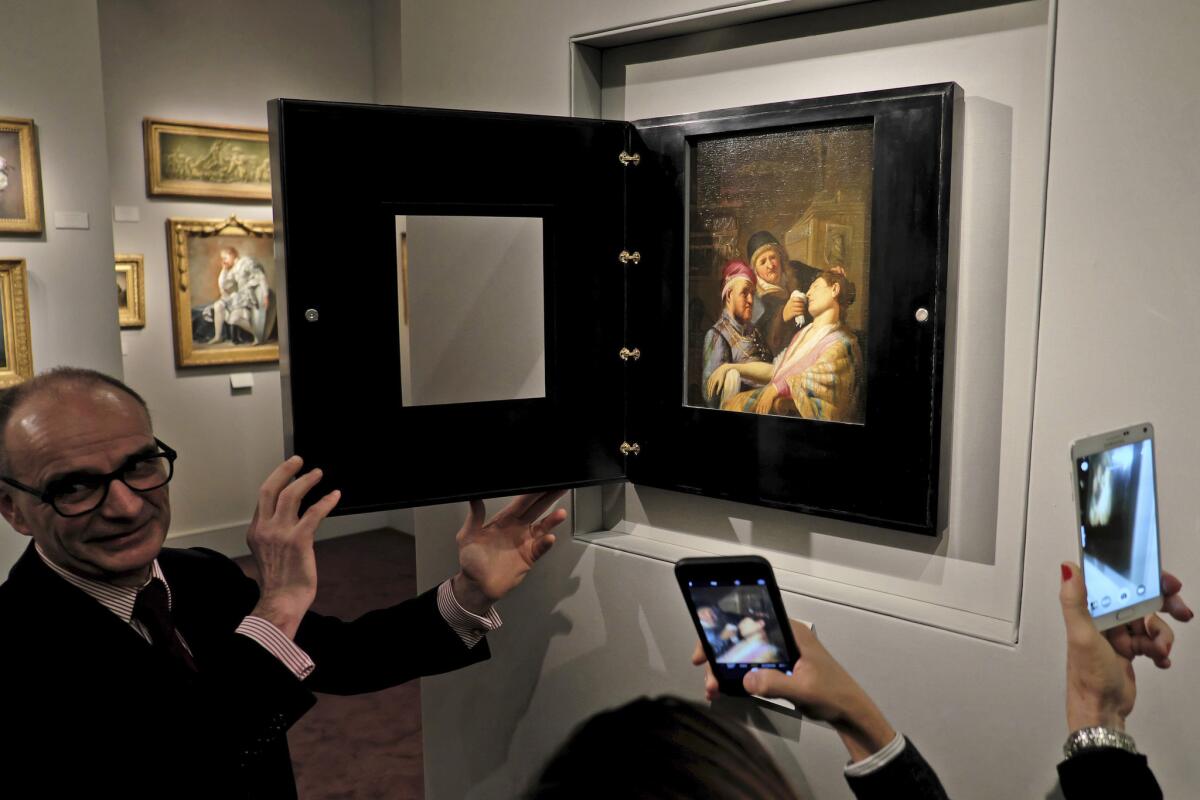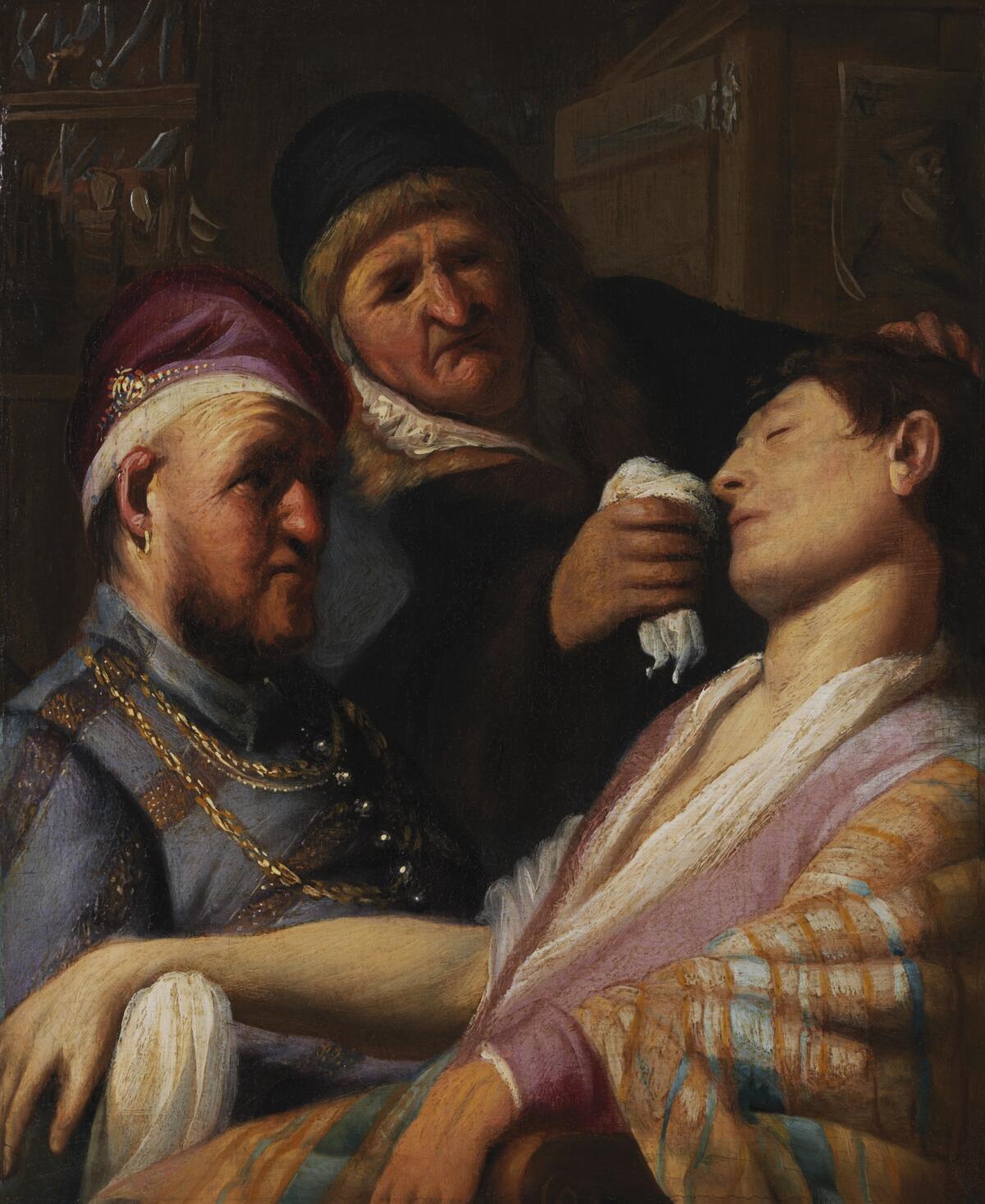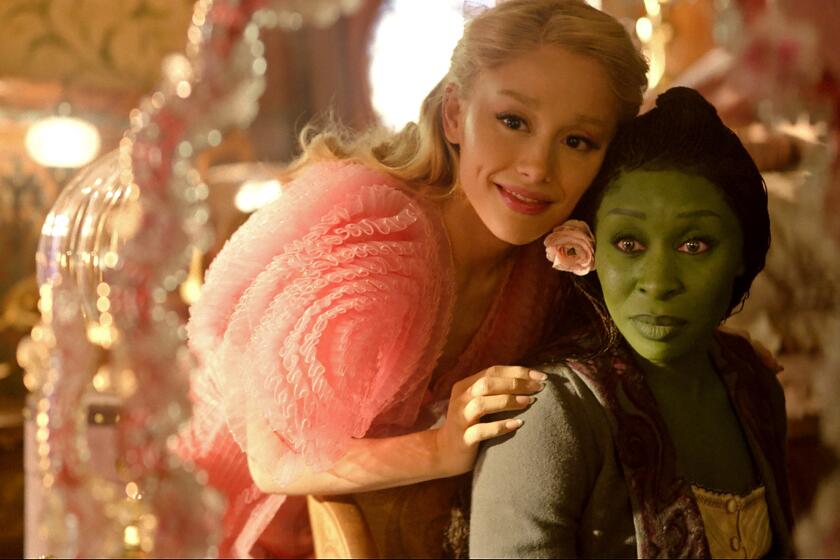The story behind a Rembrandt painting’s journey from a New Jersey basement to the Getty

When the small painting with a slightly damaged surface and cracks in its wood backing materialized in September at an auction house in New Jersey, no one expected great things.
First and foremost was its murky provenance: The artist was unknown, and so was the date of its creation. The auction house estimated that the work would sell for $500 to $800.
“We had no idea when it came up to sale that there were about to be fireworks,” said John Nye, who runs Nye & Co., based in Bloomfield, N.J.
The seemingly unremarkable painting became the talk of the international art world after it was judged to be a long-lost work by the 17th century Dutch master Rembrandt van Rijn.
The painting’s journey from a basement in New Jersey to the J. Paul Getty Museum in Los Angeles, where it will be displayed alongside other works by Rembrandt starting Wednesday, is a story that involves eagle-eyed Paris art dealers and a New York financier with deep pockets and a fondness for Dutch art.
The Getty will be the first museum to exhibit the recovered painting. “The Unconscious Patient (An Allegory of the Sense of Smell)” is among Rembrandt’s earliest known works, dating from 1624, when he was about 18. It depicts an unconscious youth receiving what could be smelling salts from one of two attendants.
The work of art stands just 9 inches tall. It was one of five pieces that the young Rembrandt created to depict the five senses. The Getty said the exhibition will feature two other paintings — hearing and touch — from the series.

Nye & Co. listed “Unconscious Patient” as a painting by an unknown artist from the 19th century.
Nye didn’t identify the northern New Jersey family that owned the painting but said he was called to their home to look at items for possible consignment. “I found it in the basement,” he said.
He said the parents had died and the brothers had taken what they wanted. He identified some art and silver that he deemed would be auction-worthy.
As for the Rembrandt, “it was in a Victorian frame,” Nye recalled. “There were a lot of reasons we surmised it was 19th century.”
Soon after the auction was announced, two Paris art dealers, Bertrand Talabardon and Bertrand Gautier, took note of the painting. “We weren’t completely certain at the time that it was authentic. ... Maybe 90% certain,” Talabardon said by phone.
The dealers, who run the Galerie Talabardon et Gautier in Paris, said they are normally wary of early Rembrandts , explaining that the artist’s students were close to him and that they created works in a style that could easily be confused for the real thing. But there were many stylistic similarities between the painting for sale and other early Rembrandts, especially those in the five-sense series, they said.
The vaguely exotic costumes worn by the characters in the painting are similar to those in the other works of the series.
They agreed to bid for the piece by phone at the Sept. 22 auction. But they weren’t the only ones who spied a potential treasure, according to Nye & Co. Two other parties from two European countries also ended up bidding for the painting, pushing up the price.
The Paris dealers ultimately prevailed, paying $870,000, or close to $1 million with the premium that auction houses typically add.
The following day, they received word that New York financier Thomas Kaplan was interested in purchasing the painting. Kaplan heads the Electrum Group, a privately owned investment management company that invests primarily in natural resources and precious metals, including gold.
Kaplan and his wife, Daphne, also own one of the world’s largest private collections of art from the Dutch Golden Age. The Leiden Collection holds works by Vermeer, Rembrandt and other painters from around the 17th century.
Gautier traveled to New York to negotiate the deal aboard Kaplan’s yacht, according to the gallery. The negotiations lasted about an hour. The gallery declined to say how much Kaplan paid for the work.
Kaplan said in an interview Friday that an alumna from his collection’s curatorial staff was working at a museum in Paris when one of the gallerists walked in and met with her boss. She later told Kaplan about the painting.
As soon as he had the work of art in his hands, “I had no doubt that it was Rembrandt,” recalled Kaplan, who studied history at Oxford. “It was pure serendipity.”
He said he purchased his first Rembrandt about a decade ago at auction and now has 10 works by the artist in his collection of approximately 200 objects. The Leiden collection also owns the two other “sense” paintings that will be on display at the Getty.
A fourth known piece from the set, the sight painting, is in the collection of the Lakenhal Museum in Leiden, the Netherlands. The whereabouts of the fifth painting in the series remain unknown.
“It’s not uncommon for works by a super-famous artist to go off the radar,” said Anne Woollett, a curator at the Getty.
After Kaplan purchased the Rembrandt, the painting was restored. During the process, which removed a layer of varnish, an artist’s monogram was discovered in the upper left corner that reads “RF.”
The monogram has been taken to stand for “Rembrandt Fecit,” or “Made by Rembrandt.” It is believed to be the earliest signature by Rembrandt on a work of art.
“After that, there was little doubt,” said Talabardon.
Kaplan said that the monogram was somewhat visible prior to restoration, “but you had to have young eyes.”
I think it’s a very exciting discovery. It shows Rembrandt at the very outset of his career.
— Arthur K. Wheelock Jr., a curator at the National Gallery of Art in Washington
The restored painting was unveiled earlier this year to great fanfare at the TEFAF art fair in Maastricht, the Netherlands.
“I think it’s a very exciting discovery,” said Arthur K. Wheelock Jr., a curator at the National Gallery of Art in Washington.
"It shows Rembrandt at the very outset of his career.” At the time, he said, the artist was changing his style “on a monthly basis.”
Over the years, Kaplan has lent the Getty works from his collection, and his new acquisition seemed like a good fit for the institution.
“In a way, it was a natural thing to do,” said Timothy Potts, director of the Getty Museum. “We have great early Rembrandts, so we are, from that perspective, the right place for this to be unveiled.”
The display is a loan, and the Getty has not acquired the painting. “Even the Getty can’t purchase everything,” Potts said.
“Unconscious Patient” will be displayed at the Getty along with Rembrandt’s “Portrait of a Girl Wearing a Gold-Trimmed Cloak” and “Portrait of a Rabbi,” both of which are on long-term loan to the Getty from the Leiden.
The exhibition will run through Aug. 28, after which it will travel internationally.
UPDATES:
May 7, 9:55 a.m.: This story updated with additional comments.
This article was originally published May 5 at 3:26 p.m.
The biggest entertainment stories
Get our big stories about Hollywood, film, television, music, arts, culture and more right in your inbox as soon as they publish.
You may occasionally receive promotional content from the Los Angeles Times.








